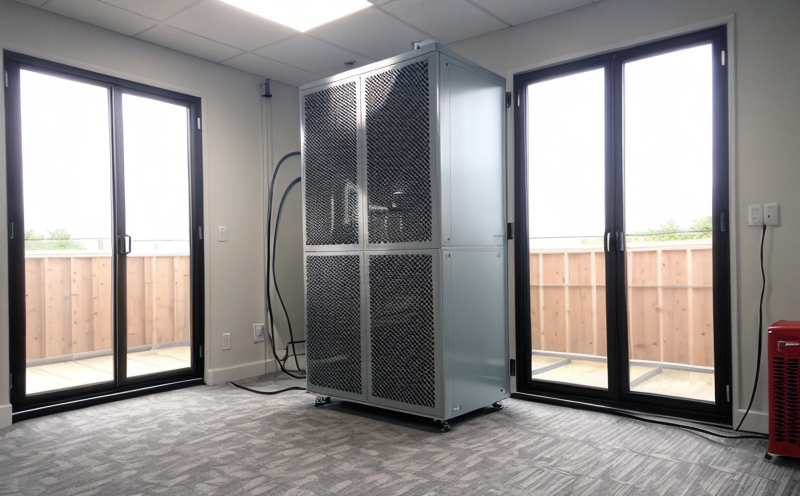EN 13779 Air Handling Unit Airflow Verification
The European Standard EN 13779 specifies the methodology for verifying the airflow of air handling units (AHUs). This standard is crucial for ensuring that AHUs operate efficiently and meet their designed performance levels. The testing procedure covers a range of parameters, including static pressure, fan speed, and system efficiency. Proper verification ensures that HVAC systems function as intended, leading to improved indoor air quality and energy savings.
During EN 13779 compliance testing, the following steps are typically taken:
- Sampling: Select a representative sample of AHUs from the production batch or installed units.
- Instrumentation Setup: Equip the AHU with appropriate flow measurement instruments such as anemometers and pitot tubes. Ensure that all test setups comply with EN 13779 requirements.
- Data Collection: Measure airflow, static pressure, fan speed, and other relevant parameters under different operating conditions. This helps in assessing the actual performance of the AHU against its design specifications.
- Compliance Check: Compare measured data with the design values as per EN 13779. Calculate system efficiency to verify adherence to the standard.
- Reporting: Generate a detailed report summarizing all test results, including any deviations from specified limits.
The importance of this service extends beyond mere compliance; it ensures that HVAC systems contribute effectively to energy conservation and occupant comfort. By adhering strictly to EN 13779 guidelines, laboratories like Eurolab can provide accurate and reliable verification results, which are essential for maintaining the integrity of HVAC equipment.
Table 1: Common Parameters Measured During EN 13779 Testing
| Parameter | Description |
|---|---|
| Static Pressure | Difference in pressure between the supply and return air ducts. |
| Airflow Rate | Volume of air passing through the AHU per unit time. |
| Fan Speed | The rotational speed of the fan motor. |
| System Efficiency | The ratio of output power to input power, indicating how efficiently energy is used. |
Table 2: Acceptance Criteria According to EN 13779
| Parameter | Critical Limits |
|---|---|
| Static Pressure Deviation | No more than ±5% from the design value. |
| Airflow Rate Variance | No more than ±10% from the design value. |
| Fan Speed Tolerance | Within ±2% of the nominal speed. |
| System Efficiency Range | Within ±5% of the expected efficiency level. |
In summary, EN 13779 testing is a critical process that ensures HVAC systems meet their design parameters and operate efficiently. This service plays an essential role in maintaining indoor air quality, reducing energy consumption, and complying with international standards.
Eurolab Advantages
At Eurolab, we pride ourselves on providing unparalleled expertise in HVAC equipment testing. Our state-of-the-art facilities and experienced team ensure that every test conducted adheres to the highest standards. Here are some of our key advantages:
- Comprehensive Services: We offer a full range of testing services for various types of HVAC equipment, including air handling units.
- ISO/IEC 17025 Accreditation: Our laboratory is fully accredited to conduct tests according to international standards like EN 13779.
- Experienced Technicians: Our team consists of highly skilled professionals with extensive experience in HVAC testing.
- Advanced Equipment: We use cutting-edge instruments and software that provide precise and reliable test results.
- Compliance Assurance: Our services help ensure that your equipment complies with international standards, thereby enhancing its marketability.
- Custom Solutions: We tailor our testing programs to meet the specific needs of our clients.
- Prompt Delivery: We understand the importance of timely results and strive to deliver reports within the shortest possible timeframe.
Choose Eurolab for your HVAC equipment testing needs, and experience the difference that expert services make in ensuring quality and compliance.
Customer Impact and Satisfaction
The benefits of EN 13779 airflow verification extend far beyond mere compliance. By ensuring that HVAC systems operate efficiently, we contribute to several key areas:
- Energy Savings: Properly verified AHUs can significantly reduce energy consumption, leading to cost savings for your organization.
- Enhanced Indoor Air Quality: Efficient HVAC systems provide better air filtration and distribution, improving overall indoor environmental conditions.
- Prolonged Equipment Lifespan: Regular verification helps identify potential issues early on, preventing costly repairs or replacements.
- Improved Comfort: Well-functioning HVAC units ensure comfortable temperatures and humidity levels in your facilities.
Our commitment to excellence has resulted in high customer satisfaction. Many of our clients have reported significant improvements in their HVAC systems' performance post-verification, leading to enhanced operational efficiency and reduced downtime. This is why Eurolab continues to be a preferred choice for quality assurance and compliance services.
Use Cases and Application Examples
The EN 13779 standard finds application in various scenarios where precise airflow verification is essential. Below are some practical examples:
- New Installation Verification: Ensuring that newly installed AHUs meet design specifications.
- Preventive Maintenance: Periodic testing to identify potential issues before they escalate into major problems.
- Audit Compliance: Meeting regulatory requirements and ensuring compliance with international standards.
- Performance Evaluation: Assessing the actual performance of existing HVAC systems against their design parameters.
- New Product Development: Validating new product designs before they enter the market.
- Retrofit Projects: Ensuring that retrofitted AHUs operate efficiently and meet modern standards.
Below are some specific use cases:





